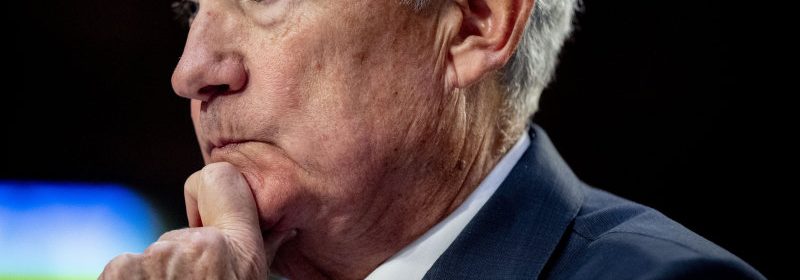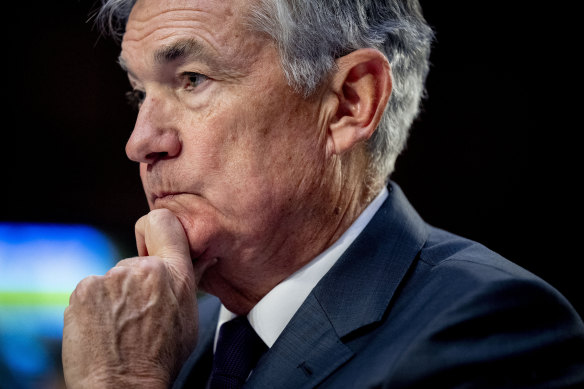Can the Fed walk and chew gum at the same time?

Tuesday’s US inflation data would, in normal circumstances, have made it close to certain that the Federal Reserve Board would announce another 50 basis point increase in interest rates at next week’s meeting. But these aren’t normal circumstances.
The collapse of two US lenders over the past week – the Silicon Valley Bank and the Signature Bank – caused turmoil in financial markets and ignited fears of widespread withdrawals of depositor funds from other regional banks and a full-scale banking crisis. The Fed was forced to take unprecedented actions to avert that threat.
It’s effectively put its $US8.3 trillion ($12.4 trillion) balance sheet behind all the $US19.4 trillion worth of deposits within the US banking system to guarantee them.
Stuck between a rock and a hard place: Fed chair Jerome Powell faces a monetary policy dilemma.Credit:AP
It’s also created a term funding facility that allows banks to borrow from the central bank using their government bond holdings as collateral, with the bonds valued at face value even though banks are carrying about $US620 billion of unrealised losses on those holdings.
The open-ended nature of those measures signals how concerned the Fed is about the threat posed by the bank collapses and their root cause – the extent to which they had realised and unrealised losses on the holdings of supposedly high-quality assets that would need to be liquidated to generate the cash required in a run on their deposits.
Those losses, crystallised or not, reflect the impact of the Fed’s aggressive monetary policy, which has seen the federal funds rate rise by 450 basis points over the last 12 months. As interest rates rise, the value of existing bonds falls in order to match the higher yields being established in the bond market.
Without the banking crisis, it would have been inevitable that the Fed would have hiked rates by another 50 basis points next week.
In this environment, with bond yields gyrating – yields crashed on Monday in response to the collapsed banks but edged back up again on Tuesday – the Fed would usually put monetary policy on hold, watching and waiting to see if its moves have stabilised the system.
The inflation data, however, has created an awkward dilemma for the Fed, which has been fighting inflation rates not seen for 40 years with the most aggressive monetary policies in 40 years.
Tuesday’s data showed a modest fall in headline inflation in the world’s largest economy, from the 6.4 per cent experienced in the year to January to 6 per cent in the year to February.
The jarring note, however, was provided by a 0.5 per cent monthly increase in “core” inflation (which excludes food and energy costs), the biggest monthly gain in almost six months. Core inflation is running at an annual rate of 5.5 per cent, only marginally lower than the 5.6 per cent recorded in January.
It is that core rate that the Fed focuses on, and it has remained stubbornly high, driven largely by housing-related costs. Some disinflation in prices for goods has been offset by continuing high levels of inflation in services.
Without the banking crisis, it would have been inevitable that the Fed would have hiked rates by another 50 basis points next week. Now it is confronted with the invidious choice between prioritising the fight against inflation or financial stability. Finding a balance between the two is akin to trying to walk while chewing gum.
There are economists and Fed watchers in the US who believe that there is a likelihood the Fed will sit on its hands next week, pausing the rate-rising cycle until the financial system settles. There are even those who think its next move, again driven by the tremors in the banking system, will be to cut rates.
The more likely outcome is that the Fed will have a bet each way, raising rates by 25 basis points to demonstrate its commitment to combating inflation and hoping that the more modest increase won’t exacerbate the issue for banks it has created with the speed and extent of its previous rate hikes.
Now [the Fed] is confronted with the invidious choice between prioritising the fight against inflation or financial stability.
Even a 25 basis-point increase will swell the unrealised losses on bank holdings of longer-dated government and mortgage-backed securities.
With analysts pumping out research of what banks’ capital positions look like if their holdings of securities are marked to market – which produces some ugly, if theoretical, outcomes – there is a risk that the Fed could trigger another round of bank runs if it does decide to press ahead with another rate rise.
There’s also, however, the risk that the gains the Fed has made on inflation, which peaked at 9.1 per cent last June, will be eroded, and high inflation rates become entrenched if it shows any signs of easing its efforts to force inflation back to its targeted rate of 2 per cent.
The proximity of next week’s meeting of the Federal Open Market Committee, which makes the rate calls, to this week’s events complicates the decision-making.
Ideally, the committee members would have had more time to see whether the Fed’s interventions had contained the banking crisis before they were asked to make a rates decision. Instead, they may have to risk a less-than-fully-informed choice between prices and financial stability.
One of the unknown factors they’ll have to consider is the impact that the banking crisis might have on business and consumer confidence. It is conceivable that it could make consumers and businesses more cautious and banks more risk-averse and conservative in their lending.
The big flows of deposits out of the smaller banks and into the far more highly regulated large and systemically important banks this week will by itself have a material impact on the smaller banks’ appetite and capacity for risk-taking and lending.
That would, in effect, dampen economic activity and tighten financial conditions even if there were no further rate rises.
The Fed, and central banks elsewhere, were too late to recognise that the outbreak of inflation was something other than transitory, which has forced them to raise rates at a pace and with a magnitude that always risked unintended consequences.
The collapse of the two banks since Friday, and the stresses those failures have generated throughout the US financial system, are the most dramatic of those unintended outcomes so far.
Given how far and fast interest rates have moved in the US and elsewhere, and the likelihood of more rate rises – if not next week, then in the coming months – there could well be more market shocks to come.
The Market Recap newsletter is a wrap of the day’s trading. Get it each weekday afternoon.
Most Viewed in Business
From our partners
Source: Read Full Article

